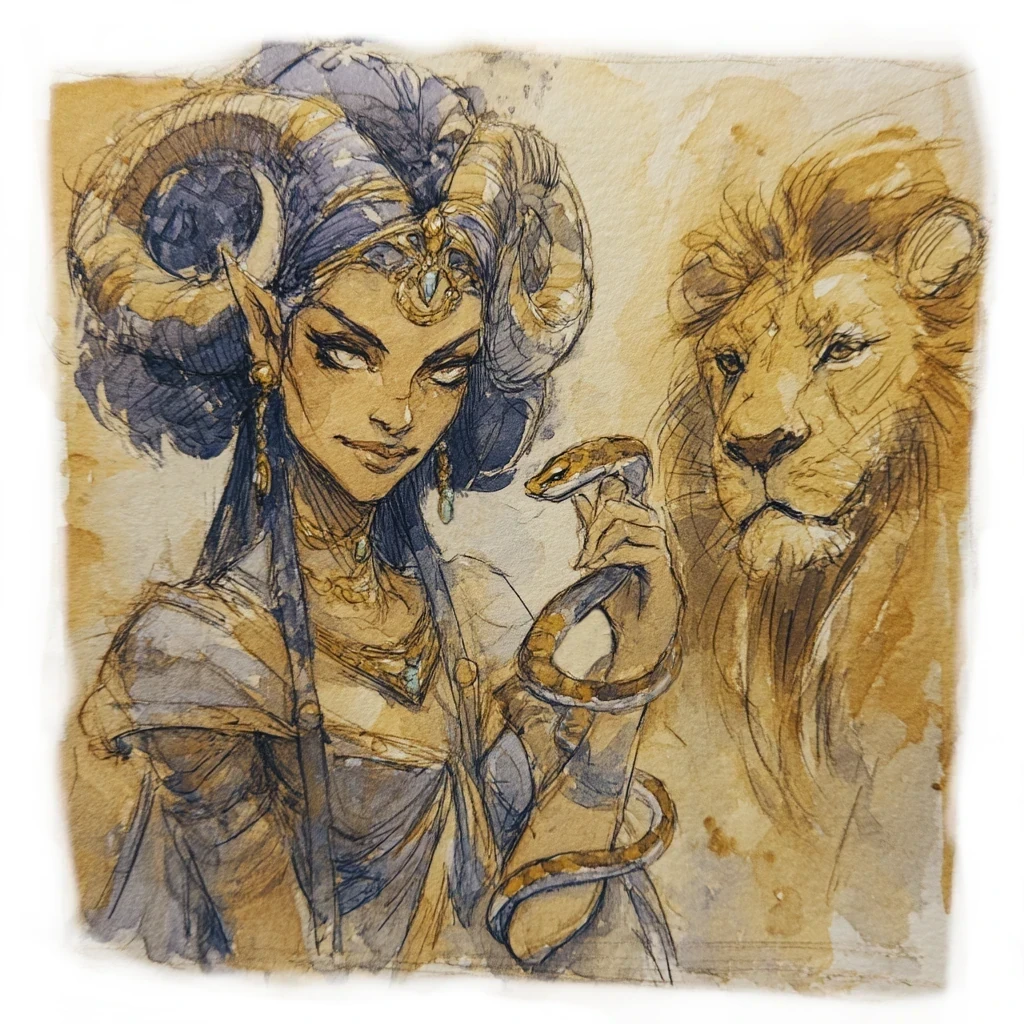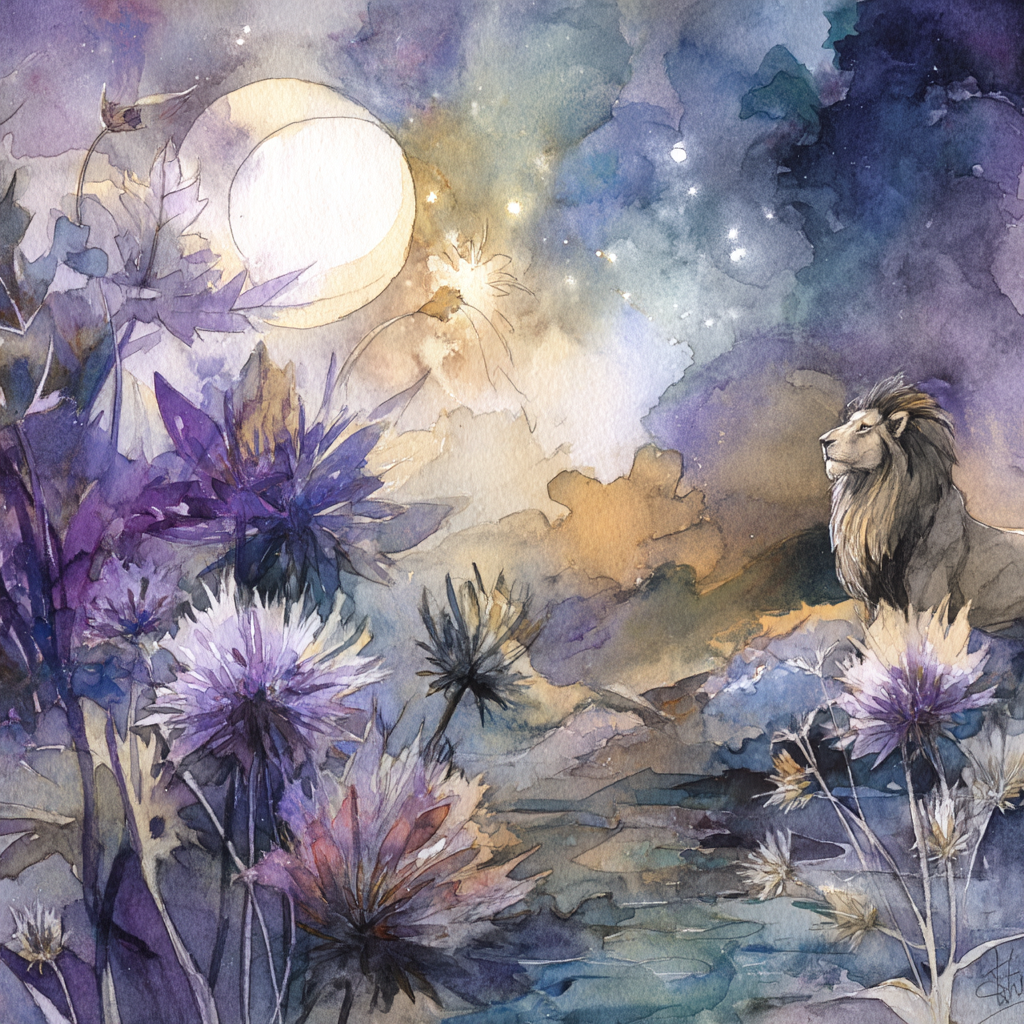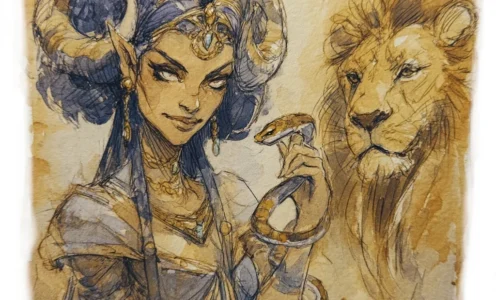[ Eladrin ] [ Aestetica | Paragons | Court of Stars ]
Qetesh

The Sacred Lover, Qadesh (planar amori eladrin empyreal lord [she/her] / CG)
Portfolio: Fertility, sacred ecstasy, celestial intimacy
Realm: Arborea / Pelion / The Starlit Garden
According to the Guvner graybeards of Sigil’s Courthouse, Qetesh (ket-TESH) is one of the most misunderstood yet profoundly benevolent eladrin empyreal lords. Before we dive into the chant about this blood, let me share this insight: Qetesh represents the purest expression of consensual intimacy, sacred celebration, and the nurturing of potential—both spiritual and literal—across the Great Ring.
Qetesh is known by many names throughout the planes: “Lady of Sacred Joy,” “the Starlit Consort,” or “the Blessed Ecstatic.” Succubus call her the “Celestial Harlot”—but that probably says more about them than it does about Qetesh. Her name derives from an ancient Egyptian word meaning “holy”, which reflects her essence as the embodiment of sacred pleasure rather than mere carnal indulgence. Among the Court of Stars, she holds the honoured title “Eye of Arborea, Without Equal,” a nod to her deep emotional insight which lets her see into the hearts of mortals.
Qetesh embodies fertility in its most comprehensive sense—not merely reproduction, but the fertile ground from which all creation springs. In her presence, ideas bloom like desert flowers after rain, and a cutter’s creative potential manifests with startling clarity. Barren wastelands in Pelion might transform into lush gardens when she’s walked through them, and many an artist or creator has been struck by sudden inspiration after honouring her name.
She’s also the embodiment of sacred ecstasy. But unlike the hollow pleasures promised by fiends, Qetesh presides over ecstatic states that elevate a body’s consciousness and connect cutters to higher truths. She represents the transcendent joy that a cutter can find in the complete acceptance of one’s authentic self. Those blessed by her presence report feeling a sense of wholeness and deep connection to the multiverse. Where Sensates seek experiences for knowledge, followers of Qetesh seek experiences that genuinely transform their psyches. Many mystical traditions across the planes incorporate elements of dance, music, and romance inspired by her teachings, creating moments where the boundaries between self and cosmos dissolve in pure joy.
The final aspect of Qetesh’s portfolio concerns intimacy in all its forms—physical sure, but also emotional, spiritual, and intellectual connections between beings. She teaches that vulnerability that is willingly shared is among the strongest forces in the multiverse, capable of healing wounds and bridging insurmountable differences. “Intimacy ain’t just what happens between lovers,” say the amori who serve her. “It’s what happens when two bashers drop their masks and truly see each other, even for just a moment. That’s the real magic, and Qetesh? She’s the high-up mistress of those moments.”
Qetesh appears as a radiant eladrin with warm bronze skin that seems to glow from within. She wears a small mountain of hair that’s actually a wig, with bovine horns attached. The style’s called a Hathor Wig—turns out Qetesh has a soft spot for the style of the Egyptian power. She loves to wear lotus flowers in her hair, and she’s often seen holding a serpent, which apparently represents wisdom and renewal. Her alternate form, like all amori eladrin, is a whirlwind of ribbon—though hers uniquely shimmer with starlight and leave traces of blooming flowers in their wake. When travelling longer distances though, Qetesh often rides upon a celestial lion—not as a demonstration of dominance, but as a symbol of the wild, untamed passion that can be channeled into creative force.
Cutters who have encountered Qetesh describe her as possessing both intense passion and profound serenity—seemingly contradictory traits that she somehow balances with effortless grace. She speaks with gentle authority, her words carrying wisdom without condescension. Qetesh laughs freely and listens intently. While she embodies joy, she is no stranger to compassion for suffering—indeed, her understanding of pleasure makes her particularly sensitive to its absence in others.
Met Qetesh once at a gathering in Brightwater.
—A planewalker spills the chant about Qetesh
She knew everyone’s name, asked after their families, remembered details from conversations centuries past.
Made you feel like the only one in the room when she spoke to you.
That’s real power, cutter—not the kind that makes folks afraid, but the kind that makes ’em feel seen.
Qetesh’s philosophy centres on what she calls “sacred reciprocity”—the idea that goodness flows from mutually beneficial exchanges, freely given. Where evil seeks to take, and even some forms of goodness seek only to give without receiving, Qetesh teaches that the highest form of goodness creates connections where all parties grow stronger through their interactions. She also rejects the notion popular in some moralistic cultures that pleasure and spirituality are somehow opposed. Instead, Qetesh demonstrates how joy and eroticism can be a pathway to compassion and understanding. Her followers learn that ecstatic experiences can break down the barriers of ego that separate beings from one another.
Among the lords of the Court of Stars, Qetesh is a counterbalance to the more martial eladrin leaders like Gwynharwyf. She’s closely allied with Faerinaal of Dreams and Lalaci of Rainbows, often collaborating on projects that bring healing to traumatized regions of the Upper Planes. Her relationship with Queen Morwel is one of mutual respect—Morwel values Qetesh’s insights on matters requiring diplomatic sensitivity and emotional intelligence. Its highly likely that they’re also lovers.
Amori under the guidance of Qetesh learn to see intimacy as a sacred art with transformative potential. They serve as healers, diplomats, and counsellors throughout Arborea, helping to resolve conflicts and heal emotional wounds. When embodying their alternate form—a whirl of bright ribbons—Qetesh has taught her followers how to briefly connect two beings in a moment of perfect understanding, a gift that has prevented countless conflicts throughout the Upper Planes.
The Starlit Garden

Qetesh’s realm in Pelion is called the Starlit Garden, and its a domain where the boundaries between desert and sky blur. It’s located in a remote part of the plane, and appears from a distance as a constellation of lights hovering just above the dunes. Visitors describe walking paths that wind between floating cloud-oases covered in exotic flowers that bloom only under starlight. Celestial lions roam freely, serving as guardians but also guides to visitors they deem worthy. At the heart of the domain stands the Temple of Sacred Union, where beings from across the Great Wheel are welcomed if they wish to heal relational wounds and learn the arts of meaningful connection.
In particular, Qetesh welcomes aasimar of all kinds to her realm—after all, these bloods are often the result of intimacy between mortal and celestial. While some celestials can be snooty or even mistrustful of their mixture of empyreal and mortal heritage, Qetesh bears no such prejudice, and in fact fights against it when she hears of it.
The Garden hosts the famous Festival of First Blossoms at the start of each celestial cycle. It’s a celebration which draws eladrin of all aestetica together in a reminder of their shared connections, and it’s one of the few times that part of Pelion could ever be described as ‘bustling’.
Source: Bestiary [PF1e] p23; Jon Winter-Holt. Canonwatch: Qetesh was mentioned in name only in the Pathfinder Bestiary as an azata empyreal lord. I’ve fleshed out the character, inspired by the power called Qetesh from Ancient Egyptian mythology.


